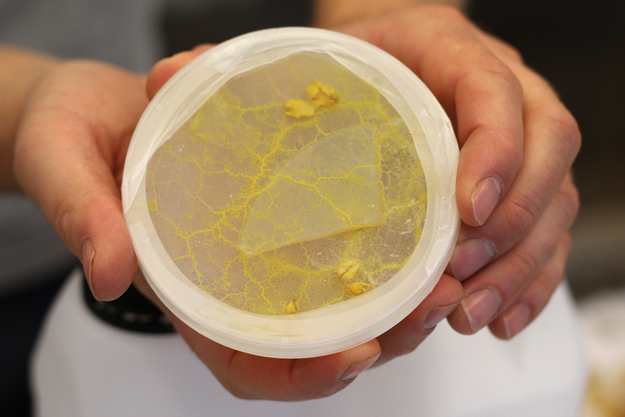What is slime mold?
Slime molds are large single celled organisms that use spores to reproduce. Their name comes from a small part of their life cycle where they can appear to look like gelatinous 'slime'. More than 900 species of slime mold, in a wide range of colours, occur all over the world and feed on microorganisms that live in any type of dead plant material. They aid in the decomposition of dead vegetation, and feed on bacteria, yeasts, and fungi.
One of the most commonly encountered slime molds is the yellow Physarum Polycephalum, found both in forests in temperate zones, as well as in classrooms and laboratories. When food is abundant a slime mold exists as a single-celled organism, but when food is in short supply, slime molds congregate and start moving as a single body. They can readily change the shape and function of parts and may form stalks that produce fruiting bodies, releasing countless spores, light enough to be carried on the wind or hitching a ride on passing animals.
Slime mold intelligence
Slime mold is smart enough to solve mazes, according to a team of Japanese and Hungarian researchers who claim that a specimen of slime mold was able to navigate a maze made of agar using the shortest route possible when two pieces of food were placed at two separate ends of the maze.
Slime mold can anticipate events and patterns. Biophysicists at the Hokkaido University repeatedly made the test environment of a specimen of slime mold cold and dry for 60-minute intervals. The slime mold anticipated the pattern by reacting to the conditions at those timed intervals.
Slime mold can map and simulate road networks. Studies have shown that with more than two sources, the amoeba produces efficient networks. The pattern connecting multiple food sources was shown to form efficient networks, linking points to one another, similar to human generated mathematical patterns. In a 2010 paper, oatflakes were dispersed to represent Tokyo and 36 surrounding towns. The slime mold created a network similar to the existing train system, and with comparable efficiency, fault tolerance, and cost. Similar results have been shown based on road networks in the United Kingdom and the Iberian peninsula. This is a video of slime mold spreading in the design of the Tokyo rail network.
Slime mold can be integrated into electronics.
The organism's reaction to its environment has been used in a USB sensor and to control a robot. Klaus-Peter Zauner at the University of Southampton developed the slime-controlled robot with colleagues from Kobe University in south-central Japan. The idea was to find simpler ways to control a robot's behaviour. Since slime mold responds to food sources, such as bacteria and fungi, by moving towards and engulfing them and also moves away from light and favours humid, moist places to inhabit, its reactions can be used to control and direct a small six-legged walking robot.
Slime mold can be used for computing.
In his book Physarum Machines, Andrew Adamatzky, professor of unconventional computing,has claimed that because slime molds appear to react in a consistent way to stimuli, they are the "ideal substrate for future and emerging bio-computing devices".
